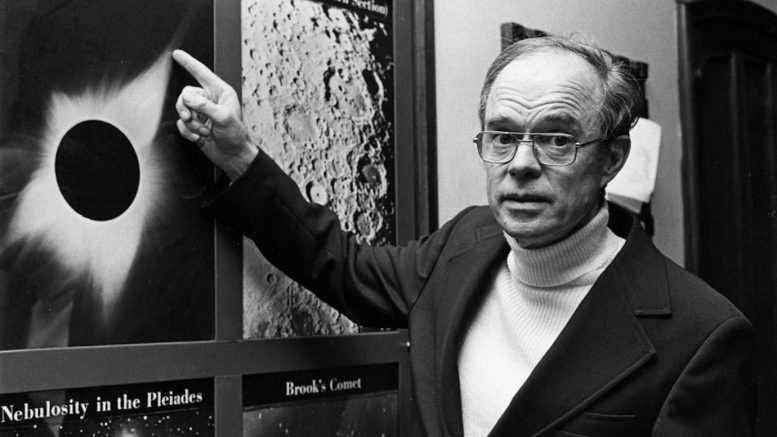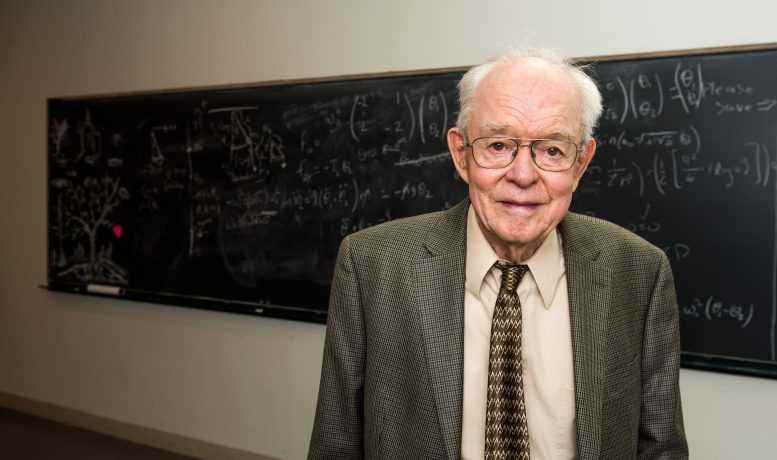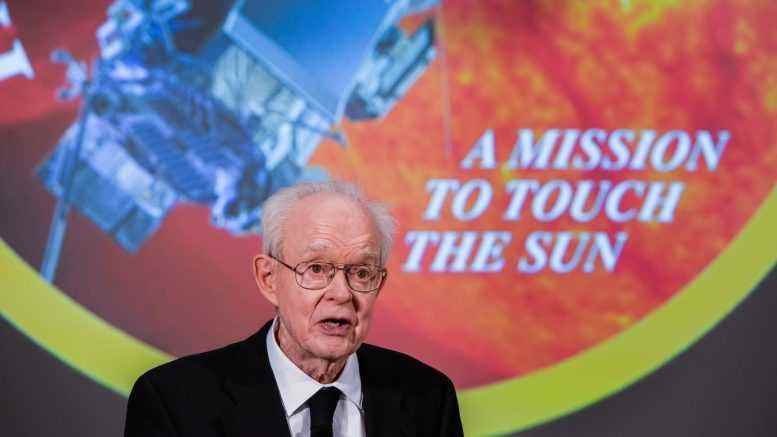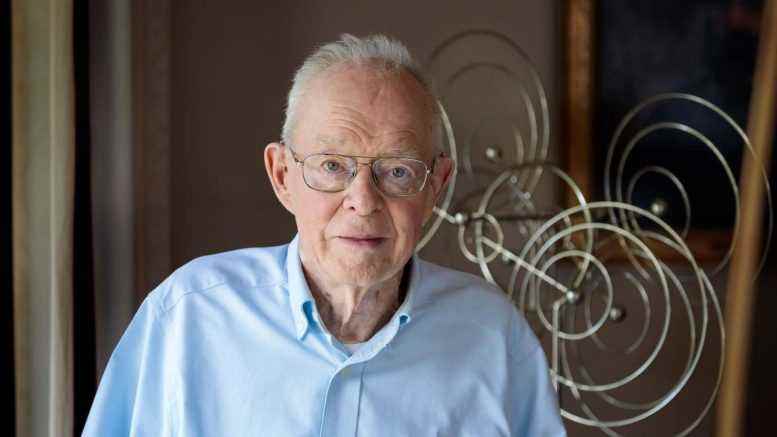Eugene Parker, Chicago Üniversitesi Astronomi ve Astrofizik Fahri Profesörü, güneş ve güneş sistemimizin anlaşılmasına ufuk açıcı katkılarıyla hatırlanıyor. Kredi: Fotoğraf John Zich/Chicago Üniversitesi
Güneş fiziğine katkıları o kadar büyük ki, öncü bir astrofizikçi olan Prof. Fahri Eugene N. Parker,[{” attribute=””>NASA named its Parker Solar Probe mission after him, died March 15. He was 94.
Parker was internationally known for proposing the concept of the solar wind—an idea that was first met with skepticism to outright ridicule. The theory was later proven to be correct, reshaping our picture of space and the solar system. Parker went on to revolutionize the field of astrophysics, unraveling the complex physics behind magnetic fields in space and the dynamics of plasma.
In August 2018, at the age of 91, he became the first person to witness the launch of their namesake spacecraft.
That same year, Parker was asked about the advice he would give to early-career scientists.

Parker, pictured in 1977. The solar wind is visible in the halo around the sun during an eclipse. Credit: Photo courtesy of the Hanna Holborn Special Collections Research Center
“I have never made a significant proposal but what there was a crowd who said, ‘Ain’t so, can’t possibly be,’” Parker responded. “If you do something new or innovative, expect trouble. But think critically about it because if you’re wrong, you want to be the first one to know that.”
“I don’t think it is in any way an overstatement to say that the field of heliophysics exists today largely because of the work of Dr. Eugene Parker,” said Nicky Fox, director of NASA’s Heliophysics Division at NASA Headquarters in Washington and a friend of Parker’s. “Even though Dr. Parker is no longer with us, his discoveries and legacy will live forever.”
Prof. Eugene Parker, güneş rüzgarıyla ilgili çığır açan keşfi de dahil olmak üzere, güneşle ilgili bilimsel araştırmasını tartışıyor. Kredi: UChicago Creative’den Video
‘Tamamen saçmalık’
1927’de Michigan, Houghton’da doğan Parker, 1948’de Michigan Eyalet Üniversitesi’nden fizik alanında lisans derecesini ve doktora derecesini 1948’de tamamladı. 1951’de Caltech’ten mezun oldu. 1955’te bir pozisyonu kabul etmeden önce Utah Üniversitesi’nde öğretim görevlisi ve yardımcı doçent olarak zaman geçirdi.[{” attribute=””>University of Chicago, where he remained for the rest of his career.
In 1957, Parker was a young assistant professor when he turned his attention to the temperature of the corona of the sun. Running through the math, he determined the conditions should produce a supersonic flow of particles off the sun’s surface.
The idea was roundly criticized. “The first reviewer on the paper said, ‘Well I would suggest that Parker go to the library and read up on the subject before he tries to write a paper about it, because this is utter nonsense,’” Parker told UChicago News in 2018.

“Physics 101 is Gene Parker’s papers. It doesn’t matter what you do, Gene Parker turns up somewhere in that literature,” said NASA Heliophysics Director Nicky Fox. Credit: Photo by Jean Lachat/University of Chicago
The paper might not have been published but for Parker’s colleague at the University, Subrahmanyan Chandrasekhar. The editor of the journal and a future Nobel laureate, Chandrasekhar didn’t like the idea either—but he couldn’t find a flaw with Parker’s math, so he overrode the reviewers and published the paper.
Shortly afterward, in 1962, NASA’s Mariner II spacecraft flew to Venus and encountered a constant stream of particles. This flow, called the solar wind, turned out to be incredibly influential on the workings of the solar system, including our lives on Earth. It blankets the planets, protecting us from harmful radiation—but also occasionally disrupting our communications, in the case of solar flares.
“Gene Parker was a legendary figure in our field—his vision of the sun and the solar system was way ahead of his time,” said Angela Olinto, the Albert A. Michelson Distinguished Service Professor of Astronomy and Astrophysics and dean of the Physical Sciences Division at the University of Chicago. “It is only fitting that Gene’s name is quite literally written in our star, the sun, and in the physics that describe stars.”
Over his career, Parker also went on to study cosmic rays and the magnetic fields of galaxies, among many other related topics. His seminal ideas include the origin of magnetic fields, known as dynamo theory; rapid dissipation of magnetic fields; the structure of magnetized shock waves; and the diffusion of high-energy cosmic rays.
“It is only fitting that Gene’s name is quite literally written in our star.”
— Angela Olinto, dean of the Physical Sciences Division
His name is littered across astrophysics: the Parker instability, which describes magnetic fields in galaxies; the Parker equation, which describes particles moving through plasmas; the Sweet-Parker model of magnetic fields in plasmas; and the Parker limit on the flux of magnetic monopoles.
“The University and the department has lost one of its giants,” said Michael Turner, the Bruce V. and Diana M. Rauner Distinguished Service Professor Emeritus of Astronomy and Astrophysics at UChicago and a colleague of Parker’s for decades. “Gene changed the course of science with his work on magnetic fields literally everywhere in the cosmos, but he remained humble and approachable, with a wry sense of humor.

Parker spoke at the University of Chicago for NASA’s announcement of the naming of the Parker Solar Probe in 2017. Credit: Photo by Jean Lachat
“He ranked up there with Stephen Hawking in his ability to express the gist of an issue, scientific or otherwise, in a few clear sentences.”
Parker twice served as chair of the Department of Astronomy and Astrophysics, and also served as chair of the astronomy section of the National Academy of Sciences.
Prof. Eugene Parker ve ailesi, Parker Solar Probe’un 12 Ağustos’ta Florida, Cape Canaveral’dan fırlatılışını izliyor. Kredi: Video UChicago Creative tarafından, fotoğraf Glenn Benson/NASA tarafından
William E. Wrather Seçkin Hizmet Astronomi ve Astrofizik Profesörü ve uzun süreli bir meslektaşı olan Robert Rosner, “Gene benim için ideal fizikçiyi temsil etti – zeki ve başarılı, cana yakın, kendini ifade edebilen ama aynı zamanda alçakgönüllü” dedi. “Bir bilim problemini keşfetmekten aldığı zevki ve daha sonra analitik becerileriyle desteklenen müthiş fiziksel kavrayışlarını asla unutmayacağım. Ve etkileşimde bulunduğu herkese, kendi öğrencilerine, doktora sonrası çalışanlarına ve meslektaşlarına verdiği cesareti asla unutamaz. Vefatı gerçekten hepimiz için büyük bir kayıp.”
1995 yılında Üniversiteden emekli oldu, ancak bu alanda çalışmalarını sürdürdü, makaleler ve kitaplar yayınladı.
2017’de NASA, dönüm noktası güneş misyonunu Heliofizik alanına yaptığı katkıların bir takdiri olarak Parker’dan sonra adlandırdığını duyurdu.
Fox, “Gene’yi “kendi” uzay aracıyla tanıştırmak için Applied Physics Lab’deki temiz odaya alma onuruna sahip olmak çok heyecan vericiydi – ve tabii ki “Parker, Parker ile tanışın” dedim.
“Her yeni görüntüde veya veri planında gözlerinin parlaması – bu, her zaman evrenimiz hakkında daha fazla şey öğrenmeye çalışan gerçek Gen’di.”
– NASA’nın Heliofizik Bölümü Direktörü Nicky Fox
12 Ağustos 2018 sabahı, Parker, Cape Canaveral’da idi adaşının lansmanına tanık olmak için ailesinin üç nesliyle Parker Güneş Probuo zamandan beri güneş etrafında birden fazla dönüş yaptı ve olağanüstü veriler topladı.
Fox, “Onunla görevden elde ettiğim yeni sonuçları her paylaştığımda Gene’nin gösterdiği devam eden neşe – her yeni görüntüde veya veri planında gözlerinin parlaması – işte bu gerçek Gene idi, her zaman evrenimiz hakkında daha fazla şey öğrenmeye çalışıyor,” Fox dedim.

Eugene Parker, 2017’de 90. yaş gününü kutlamak için bir pastanın üzerindeki mumları üflerken, fizik bölümü başkanı Young-Kee Kim de dahil olmak üzere meslektaşlarıyla çevrili, ayrıldı. Kredi bilgileri: Fotoğraf Jean Lachat
Parker’ın birçok ödülü arasında ABD Ulusal Bilim Madalyası, Kyoto Ödülü, Crafoord Ödülü, Amerikan Fizik Derneği Araştırmada Olağanüstü Başarı Madalyası ve James Clerk Maxwell Ödülü bulunmaktadır. Ulusal Bilimler Akademisi’ne seçildi ve Amerikan Fizik Derneği üyesi ve Amerikan Astronomi Derneği’nin Eski Üyesiydi.
Dört kitap yazdı: Gezegenler Arası Dinamik Süreçler (1963), Kozmik Manyetik Alanlar: Kökenleri ve Faaliyetleri (1979), Yıldız X-ışınlarına Uygulamalarla Manyetik Alanlarda Spontan Akım Levhaları (1994) ve Evrendeki Elektrik ve Manyetik Alanlar Üzerine Sohbetler (2007).
Oğlu Eric Parker, “Babamın kaybı bizi harap etti, ancak mirasının sadece ailemizi ve arkadaşlarımızı değil, dünyanın dört bir yanındaki uluslararası bilim insanları topluluğunu da kapsadığını biliyoruz” dedi. “Anılarla ulaşan herkese, ona çok keyif veren bir konuyu keşfetmek için yıllar boyunca onunla birlikte çalışan meslektaşlarına ve babamı karşılayan NASA ve Uygulamalı Fizik Laboratuvarı’ndaki birçok kişiye şükranlarımızı sunuyoruz. ve ona derin bir hediye verdi – onu derinden etkileyen Parker Solar Probe’un lansmanını görme şansı.”
Parker, 2020’de kazandığı Crafoord Ödülü’nü kutlamak için önümüzdeki ay İsveç’te bir törene davet edildi. Ailesi, Parker adına törene katılmayı planlıyor.
Parker, 67 yıldır evli olduğu eşi Niesje ve kardeşi Phillip tarafından hayatta kaldı; oğlu Eric Glenn Parker (Susan ile evli) ve kızı Joyce Marie Parker (Ed ile evli); torunları Owen Loh (Allison ile evli), Miles Loh (Michelle ile evli) ve Nolan Loh (nişanlısı Hillary Wang); ve torunların torunları Lena ve Elliott.
Eugene N. Parker’ın yaşamı ve ölümü hakkında daha fazla bilgi için bkz. NASA Vizyoner Heliofizikçi Eugene Parker’ın Ölümünün Yasını Tutuyor.

